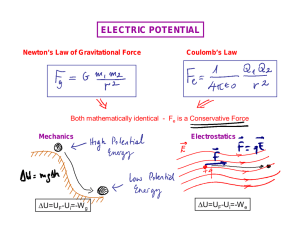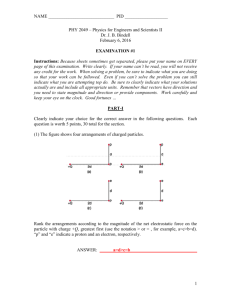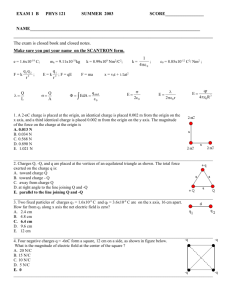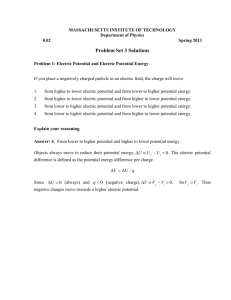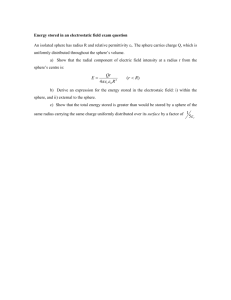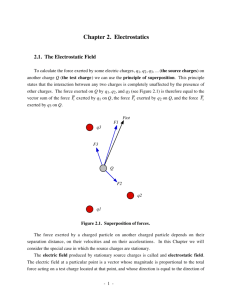ps04sol
advertisement
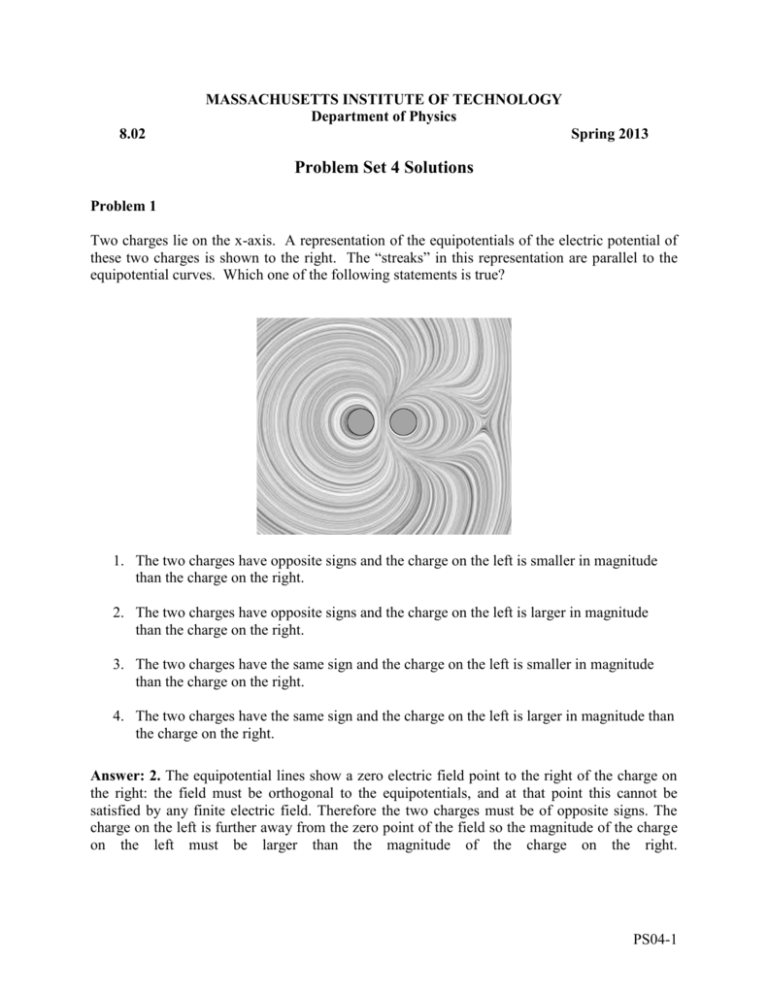
MASSACHUSETTS INSTITUTE OF TECHNOLOGY Department of Physics 8.02 Spring 2013 Problem Set 4 Solutions Problem 1 Two charges lie on the x-axis. A representation of the equipotentials of the electric potential of these two charges is shown to the right. The “streaks” in this representation are parallel to the equipotential curves. Which one of the following statements is true? 1. The two charges have opposite signs and the charge on the left is smaller in magnitude than the charge on the right. 2. The two charges have opposite signs and the charge on the left is larger in magnitude than the charge on the right. 3. The two charges have the same sign and the charge on the left is smaller in magnitude than the charge on the right. 4. The two charges have the same sign and the charge on the left is larger in magnitude than the charge on the right. Answer: 2. The equipotential lines show a zero electric field point to the right of the charge on the right: the field must be orthogonal to the equipotentials, and at that point this cannot be satisfied by any finite electric field. Therefore the two charges must be of opposite signs. The charge on the left is further away from the zero point of the field so the magnitude of the charge on the left must be larger than the magnitude of the charge on the right. PS04-1 Problem 2 Partial Derivatives and the Gradient Introduction: For one-dimensional functions of a single variable, e.g. f (x) , the derivative, df / dx or f '(x) , tells you how the function changes for small changes in the independent variable x. When a function depends on several variables, e.g. f (x, y, z) , there are several different derivatives, called partial derivatives, ¶f / ¶x , ¶f / ¶y , and ¶f / ¶z . Both in concept and in practice the partial derivative is the same as the one-dimensional derivative, asking how the function changes as you change one of its independent variables (while holding the others fixed – treat them as constants when you take the derivative). Consider a point-like positively charged object with charge +q located at the origin. Choose V (¥) = 0 then we determined in class (W03D2 class) that the electric potential difference V (r) - V (¥) = V (r) between infinity and any point on a sphere of radius r centered on the origin is given by the expression V (r) = ke q . r (a) Find an expression for the potential in Cartesian coordinates (x, y, z) . Solution: V (x, y, z) = ke q x2 + y2 + z 2 (b) Calculate the three derivatives, called partial derivatives, ¶V / ¶x , ¶V / ¶y , and ¶V / ¶z . Solution: ke q -k q -keqx ¶V ¶ 2x = = e = 3 ¶x ¶x x 2 + y 2 + z 2 2 (x 2 + y 2 + z 2 ) 2 r3 ke q -k q -keqy ¶V ¶ 2y = = e = 3 ¶y ¶y x 2 + y 2 + z 2 2 (x 2 + y 2 + z 2 ) 2 r3 ¶V ¶ = ¶z ¶z ke q x2 + y2 + z 2 = -ke q -ke qz 2z = 3 2 (x 2 + y 2 + z 2 ) 2 r3 PS04-2 Gradient: It is also convenient to define the gradient of a multidimensional scalar function. The gradient is a vector field that everywhere points in the direction of maximum change (steepest ascent uphill) of the function. It is calculated as follows: Ñf = (c) Again consider V (x, y, z) = ¶f ¶f ¶f î + ĵ + k̂ . ¶x ¶y ¶z ke q x2 + y2 + z 2 . Calculate its gradient ÑV . Use the fact that r = xî + yĵ + zk̂ and r = x 2 + y 2 + z 2 to express your answer in terms of ke , q , r , and r . Solution: ÑV = -k qx k qy k qz ¶V ¶V ¶V r î + ĵ + k̂ = e3 î - e 3 ĵ - e 3 k̂ = -ke q 3 ¶x ¶y ¶z r r r r (d) Based on your answer to part (c), what is the relationship between ÑV and the electric field E. Solution: This should look familiar – it’s the negative of the electric field created by a point charge, ÑV = -E (e) (i) For a point-like charged object, does the gradient ÑV point in the direction of maximum increase or maximum decrease of the function V ? Explain your reasoning. (ii) Does the sign of the charge effect your answer to part (i)? Explain your reasoning. Solution (i) The direction of the gradient is the minus the direction of the electric field. For a point-like positively charged object, the electric field points away from the point object. Therefore the ÑV = -E points towards the point like object. For q > 0 , V (r) = keq / r increases fastest when you move radially inward so the direction of the gradient points in the direction of maximum increase of the function V . (ii) If q < 0 , the electric field points towards the origin, so ÑV = -E points radially outward. The function V (r) = keq / r increases as you move radially outward when q < 0 . Therefore the direction of the gradient points in the direction of maximum increase of the function V regardless of the sign of the charge. Generalization: Finding the Electric Field from the Electric Potential PS04-3 Your results for the point-like charged object generalize to any source of electric field. Because the electrostatic force on a charged object in an electrostatic field is a conservative force, the line B integral òF elec × d s is path independent and hence in class (W03D2) we defined the electric A potential difference by B B Ft × d s = - ò Es × d s . q A t A V (B) - V ( A) = - ò Whenever a line integral of a function is independent of the path, the line integral can be written as B V (B) - V ( A) = ò ÑV × d s . A Comparing our two expressions we see that E = -ÑV . (f) Using the result that E = -ÑV , does the electric field depend on your choice of point for the zero reference electric potential? Explain your reasoning. Solution: If we changed our zero reference point, then we are changing a electric potential function by a constant V0 . However the gradient of a constant is zero we get the same answer for the electric field. We expect this because the electric field is unique since if we place a charged object at a point P the force on that object is Fq = qE . Two different electric field would give two different forces which contradicts physical experience. PS04-4 Problem 3 Suppose that the electric potential varies along the x-axis as shown in the figure below. The potential does not vary in the y- or z -direction. Of the intervals shown (ignore the behavior at the end points of the intervals), determine the intervals in which Ex has (a) its greatest absolute value. (b) its least. (c) Plot Ex as a function of x. (d) What sort of charge distributions would produce these kinds of changes in the potential? Where are they located? Solution PS04-5 ¶V , the greatest absolute value of Ex corresponds to the interval in which V ¶x changes most steeply. From the graph, we see that this occurs in interval ab, 15 - (-10) with Ex = = -25, or | Ex |= 25 . (-2) - (-3) (a) Since Ex = - (b) The smallest absolute value of Ex corresponds to the interval in which V changes the least. From the graph, we see that this occurs in interval cd, with Ex = 0 . (c) A plot Ex as a function of x is shown in the figure below. (d) These kinds of changes in the potential can be produced with sheets of charge extending in the yz direction located at points b, c, d, etc. along the x-axis. Note again that a sheet of charge with charge per unit area will always produce a jump in the normal component of the electric field of magnitude s / e 0 . PS04-6 Problem 4 Two parallel infinite non-conducting plates lying in the xy-plane are separated by a distance d . The upper plate located at z = d / 2 is uniformly positively charged with surface charge density +s . The lower plate located at z = -d / 2 is uniformly negatively charged with surface charge density -s . a) Find the electric field in the regions (i) z > d / 2 , (ii) z < -d / 2 , (iii) -d / 2 < z < d / 2 . b) Find the electric potential difference V (d / 2) - V (-d / 2) . Solution: The electric field due to the two planes can be found by applying the superposition principle to the result obtained in Example 4.2 for one plane. Since the planes carry equal but opposite surface charge densities, both fields have equal magnitude: E+ = E- = s 2e 0 The field of the positive plane points away from the positive plane and the field of the negative plane points towards the negative plane Therefore, when we add these fields together, we see that the field outside the parallel planes is zero, and the field between the planes has twice the magnitude of the field of either plane. PS04-7 The electric field of the positive and the negative planes are given by ì s ˆ ï+ 2e k , z > d / 2 ï 0 E+ = í s ïkˆ , z < d / 2 ïî 2e 0 ì s ˆ ï- 2e k , z > -d / 2 ï 0 E- = í s ï+ kˆ , z < -d / 2 ïî 2e 0 , Adding these two fields together then yields ì0 k̂, z>d/2 ï ï s E = í- k̂, d / 2 > z > -d / 2 ï e0 ï0 k̂, z < -d / 2 î (1) Note that the magnitude of the electric field between the plates is of a single plate, and vanishes in the regions and . , which is twice that b) The electric potential difference between the plates is then z=d /2 V (d / 2) - V (-d / 2) = - ò z=-d /2 æ s ö ò ç - e k̂ ÷ø × dzk̂ z=-d /2 è 0 z=d /2 E×ds = - s z=d /2 s sd = dz = ((d / 2) - (-d / 2) = ò e0 z = - d / 2 e0 e0 PS04-8 Problem 5 Consider a uniformly charged sphere of radius R and charge Q . Find the electric potential difference V (r) - V (0) between any point lying on a sphere of radius r and the point at the origin, for (a) 0 < r < R and (b) r > R . Choose the zero reference point for the potential at the origin, i.e. V (0) = 0 . (c) Make a plot of V (r) vs. r . Solution: In order to solve this problem we must first calculate the electric field as a function of r for the regions 0 < r < R and r > R . Then we integrate the electric field to find the electric potential difference between any point lying on a sphere of radius r and the point at the origin. Because we are computing the integral along a path we must be careful to use the correct functional form for the electric field in each region that our path crosses. There are two distinct regions of space defined by the charged sphere: region I: , and region II: . So we shall apply Gauss’s Law in each region to find the electric field in that region. For region I: , we choose a sphere of radius r as our Gaussian surface. Then, the electric flux through this closed surface is òò E I × d A = EI × 4p r 2 . The sphere has a uniform charge density r = Q / (4 / 3)p R3 . Because the charge distribution is uniform, the charge enclosed in our Gaussian surface is given by Qenc e0 = r(4 / 3)p r 3 Q r 3 . = e0 e 0 R3 Now we apply Gauss’s Law: òò E I × dA = Qenc e0 . to arrive at: PS04-9 EI × 4p r 2 = Q r3 . e 0 R3 which we can solve for the electric field inside the sphere EI = EI r̂ = Qr r̂ , 0 < r < R . 4pe 0 R3 For region II: : we choose the same spherical Gaussian surface of radius electric flux has the same form òò E II , and the × d A = EII × 4p r 2 . All the charge is now enclosed, Qenc = Q , then Gauss’s Law becomes EII × 4p r 2 = Q e0 . We can solve this equation for the electric field EII = EII r̂ = Q 4pe 0r 2 r̂ , r > R . In this region of space, the electric field falls off as 1 / r 2 as we expect since outside the charge distribution, the sphere acts as if all the charge were concentrated at the origin. Our complete expression for the electric field as a function of r is then PS04-10 ì Qr r̂ , 0 < r < R ïEI = EI r̂ = 4pe 0 R3 ï E(r) = í ïE = E r̂ = Q r̂ , r > R II ï II 4pe 0 r 2 î We can now find the electric potential difference between any point lying on a sphere of radius r and the origin, i.e. V (r) - V (0) . We begin by considering values of r such that 0 < r < R . We shall calculate the potential difference by calculating the line integral r¢=r V (r) - V (0) = - ò EI × d r ¢ ; 0 < r < R r ¢ =0 We use as integration variable r ¢ and integrate from r ¢ = 0 to r ¢ = r : r¢=r r¢=r Qr ¢ Qr ¢ Qr 2 V (r) - V (0) = - ò r̂ × dr ¢r̂ = - ò dr ¢ = ; 0<r < R 4pe 0 R3 4pe 0 R3 8pe 0 R3 r ¢ =0 r ¢ =0 For : we are taking a path from the origin through regions I and regions II and so we need to use both functional forms for the electric field in the appropriate regions. The potential difference between any point lying on a sphere of radius r > R and the origin is given by the line integral expression r¢= R V (r) - V (0) = - ò r¢=r EI × d r ¢ - r ¢ =0 ò EII × d r¢ ; r > R . r¢= R Using our results for the electric field we get that r¢= R V (r) - V (0) = - r¢=r Qr ¢ Q ò 4pe R3 r̂ × dr ¢r̂ - ò 4pe r ¢2 r̂ × dr ¢r̂ ; r > R r ¢ =0 r¢= R 0 0 This becomes r¢= R V (r) - V (0) = Integrating yields r¢=r Qr ¢ Q ò 4pe R3 dr ¢ - ò 4pe r ¢ 2 dr ¢ ; r > R r ¢ =0 r¢= R 0 0 Qr ¢ 2 V (r) - V (0) = 8pe 0 R3 r¢= R + r ¢ =0 Q r¢=r 4pe 0 r ¢ r ¢ = R ; r>R Substituting in the endpoints yields V (r) - V (0) = - Q 8pe 0 R + Q æ1 1ö ; r>R 4pe 0 çè r R ÷ø A little algebra then yields V (r) - V (0) = Q 4pe 0 r - 3Q 8pe 0 R ; r>R Thus the electric potential difference between any point lying on a sphere of radius r and the origin (where V (0) = 0 ) is given by ì Qr 2 ; 0<r < R ï3 ï 8pe 0 R V (r) - V (0) = í ï Q - 3Q ; r > R ï 4pe 0 r 8pe 0 R î When we set V (0) = 0 , we have an expression for the electric potential function ì Qr 2 ; 0<r < R ï3 ï 8pe 0 R V (r) = í ï Q - 3Q ; r > R ï 4pe 0 r 8pe 0 R î We plot V (r) vs. r in the figure below. Note that the graph of the electric potential function is continuous at r = R .
